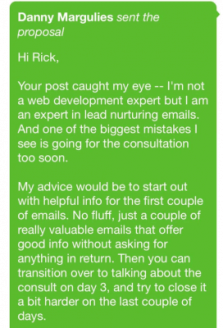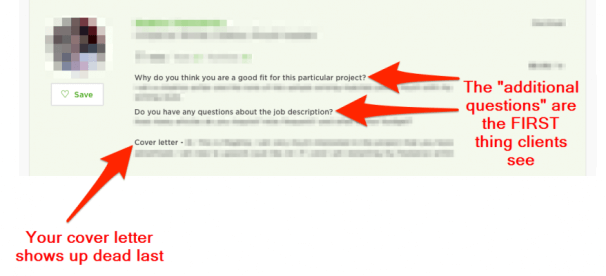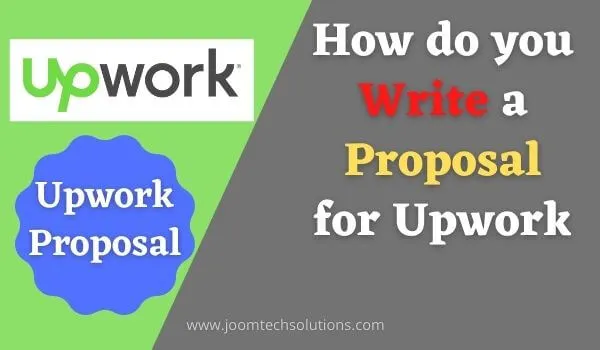Imagine being able to attain every project that catches your eye with confidence, knowing you’ll have a good chance of landing a new client. Knowing what works for other freelancers might give you the confidence you need to produce fantastic, winning proposals quickly and consistently. So you should know how to write an Upwork Proposal?
Before you proceed, make sure to: There are 3 “invisible questions” that every proposal must answer.
To write a successful proposal, you must first understand what is going on in the client’s mind.
I’ve identified three important questions practically all clients want to answer in your proposals after years of carefully evaluating and analyzing tens of thousands of Upwork proposals (not to mention creating a few thousand myself).
But here’s an amazing fact: despite their strong interest in these responses, clients hardly ever ask for them!
Not directly, at least.
Let See: How to boost your proposal on Upwork with connects?
That is why I call them “Invisible Questions.”
Invisible Question 1: “Are you capable of doing my project?”

credit: Upwork
Clients want to know that you can complete not just any similar project, but their specific one as well. While most “web design” or “article writing” projects may appear identical to us as freelancers, each client’s project is unique!
It’s similar to how parents view their children: they may act and play like other children, yet they are completely unique to their parents and demand their own personal care and attention.
Understanding, appreciating, and acknowledging this aspect of the client’s mentality will go a long way toward converting them.
Invisible Question 2: “Will you make my life easier?”
Let See: Top 10 Upwork Mistakes Made by New Freelancers
Clients are busy men with lots of projects, they need help from you.
They’re looking for signs that working with you won’t be another task on their to-do list—that you’ll be approachable and proactive.
Consider your proposal to be more than just another “pitch,” but a sneak peeks into what it’s like to work with you.
Instead of dumping a link to their complete portfolio (which can be confusing and time-consuming for the client to go through—more on this later), a logo designer might choose a few relevant samples of their work to show immediately in their proposal. It’s simple to pay more attention in this way. Clients notice, and appreciate it when you go out of your way to save them time and energy.
Invisible Question 3: “Do you care about helping me succeed?”
Let See: Top 10 Upwork Cover Letter Samples
This is a challenging one for freelancers to adjust to because it may appear on the surface that your talents and price are the only things that matter.
However, all of the top clients I know make hiring decisions that are based on how they feel about you at least as much as anything else.
Clients on Upwork want to know that you’ll be there for them. They want to know you’re not only technically capable, but also that you’ve got their back and are willing to go the additional mile to help them achieve, as well as make them seem good and impress the people in their lives (e.g., their customers, associates, etc.).
One reader shared how a repeated client chose her more for her attitude than her technical skills in a discussion on the Freelance to Win website:
“I’m a graphic designer on Upwork… I recently had a “failed job” experience – my client had hired 2 designers on Upwork for the project. They liked her designs better (they really were better) but because I cared more about the project and was willing to go back and figure out what was different, his team went with me and he’s now a repeat client.”
4 Proposal tips to boost your success rate instantly
Let See: Professional Upwork Profile
Tip 1: Avoid “hybrid” Upwork proposals
In a previous post about how to create winning proposals, I discussed the risks of copying and pasting canned or pre-written proposals for any project you’re interested in.
Many people have asked since then:
“What if I create a strong proposal template and then change it for each project?”
In concept, a “hybrid” proposal method like this one could save you time and energy while avoiding the risk of a premade proposal.
However, when you look at the risk/reward ratio, I don’t think there’s any reason. You might save a few minutes here and there at most; at worst, you could lose tens of thousands of dollars per year (or more). Things better to take a few additional minutes and do it well the first time. You’ll notice that following the suggestions in this piece isn’t all that difficult.
Let See: How can I get free connects on Upwork?
Tip 2: Show off a relevant example of your work
There may be no better method to convince them that you can complete their job successfully than to offer them an example of something comparable you’ve completed previously.
Before all of the “non-creatives” groan and say, “Oh, that’s only for writers and designers!” Anyone — in any Upwork work category — may provide an example of their work in a proposal, I guarantee you.
All it takes is a little creativity and thinking outside the box.
The process is straightforward: you generate a sample piece of work that is comparable to — but not identical to — what a client requires. This demonstrates to clients that you are capable of completing their assignments without mistakenly performing “free work” for them (which is never a good idea).
Let See: How much do Upwork connects cost?
Tip 3: Make a good start to your Upwork proposal.
Consider the following idea for a new television show: If they don’t hook you with the first episode, it won’t matter what follows because you’ll most likely be tuned out by then.
Your proposals are subject to the same rule. To get clients interested in you, you don’t need to be a fantastic TV writer; all you need to do is get to the point – quickly.
The goal of your proposal, from the client’s perspective, is the information that will assist them.
That’s where you say things like, “Hey, I worked on a project that I think is relevant to this. Here’s some additional information on the subject…” OR “Hey, you stated X, Y, and Z, and here are some ways I think we could solve that,” for example. “Hey, Ms. Client, here are a couple of common problems on this project that I’d want to assist you to avoid…”
When you swiftly get to the issues that the client cares about, they begin to think, “Wow, this person absolutely gets it.” She’s so helpful!” or “He appears to know exactly what he’s doing.”
To break the ice, it’s fine to start with a nice warm-up sentence. However, if you continue to ramble, you will quickly lose their interest.
Tip #4: Don’t limit yourself to the budget set by the client.
When a client specifies a budget in their project posting, it can be a helpful guideline or starting point, but it doesn’t have to be flat.
Perhaps a client set a price that you feel is too low for what they’re asking for. That’s fine; freelancers typically have a better idea of what their services should cost than the client. Perhaps you think you can offer enough value to their project to justify a higher cost.
The most important thing to remember is that you can price more than the client’s budget and still get hired.
Common Upwork proposal mistakes (that even experienced freelancers make)
Let See: How do hide client feedback on Upwork?
Mistake #1: Taking “Preferred Qualifications” too literally
Before you pass up a new chance because you don’t think you meet a client’s requirements, keep in mind that there is only one question you should be asking yourself:
“Is it possible for me to offer value to this project?”
If you answered yes, regardless of the client’s Preferred Qualifications, you should consider submitting a proposal.
If you’re still unsure, return to the three “invisible questions”:
- Are you capable of completing the project successfully?
- Is it possible for you to make the client’s life easier?
- Do you care enough to help them in their victory?
Do you really think the client wouldn’t want to hear from you if you answered yes to all three questions? As a current client, I know how much I would appreciate a proposal from anyone who can honestly say yes to all of these questions. (And no, if you don’t fulfill the preferred requirements, your proposal won’t be concealed from clients.) Take a chance!
Mistake #2: Writing your proposal “upside down”

Let See: How do you get your first Upwork job?
Perhaps you’ve noticed that after you’ve written your cover letter, several Upwork project postings ask you to answer one or more “Additional Questions.”
What you may not realize is that the answers to these “Additional Questions” are what clients view first when your proposal appears on their screen.
This is important information, not only because it indicates you should dedicate at least as much time to “Additional Questions” as you should to your cover letter, but also because the client chose to include the questions as “Screening Questions” in the first place. The client may not go on to your cover letter if you don’t respond well to their questions (let alone check out your profile, portfolio, etc).
Now that you’re aware of this, you may tailor your cover letter to fit the situation. Turn it around! Instead of thinking of it as the “main course” and the additional questions as an afterthought, regard it as the “main course.”
Answer completes the other questions first, using some of the strategies discussed in this article. A query about your level of expertise, for example, can be converted into an opportunity to show off a relevant piece of work; a question about which element of the project you believe would be the hardest can be turned into an opportunity to offer a strategic thought or recommendation.
Mistake #3: Trying too hard to sell.

No one enjoys being sold something.
My preferred method is more natural, enjoyable, and effective. Instead of asking myself, “How can I sell this client?” I should be asking myself, “How can I help this client?”.
This results in better proposals and a higher client response rate. It’s also easier since I can just be myself rather than putting on a show for the sake of “selling.”
This results in better proposals and a higher client response rate. It’s also easier since I can just be myself rather than putting on a show for the sake of “selling.”
A freelancer Danny Margulies shared with you something wonderful. It’s a two-minute clip from an audio interview he had with Chris Davis, an Upwork premium client. You’ll hear him explain why he chose to hire him for $135/hr in his own words.
Pay close attention to the types of words Chris uses:
- “Trust”
- “Being a human being”
- “Getting to know you”
- “You weren’t trying to sell me”
- “You respected me”
- “You talked to me like a person”
- “People crave connection”

